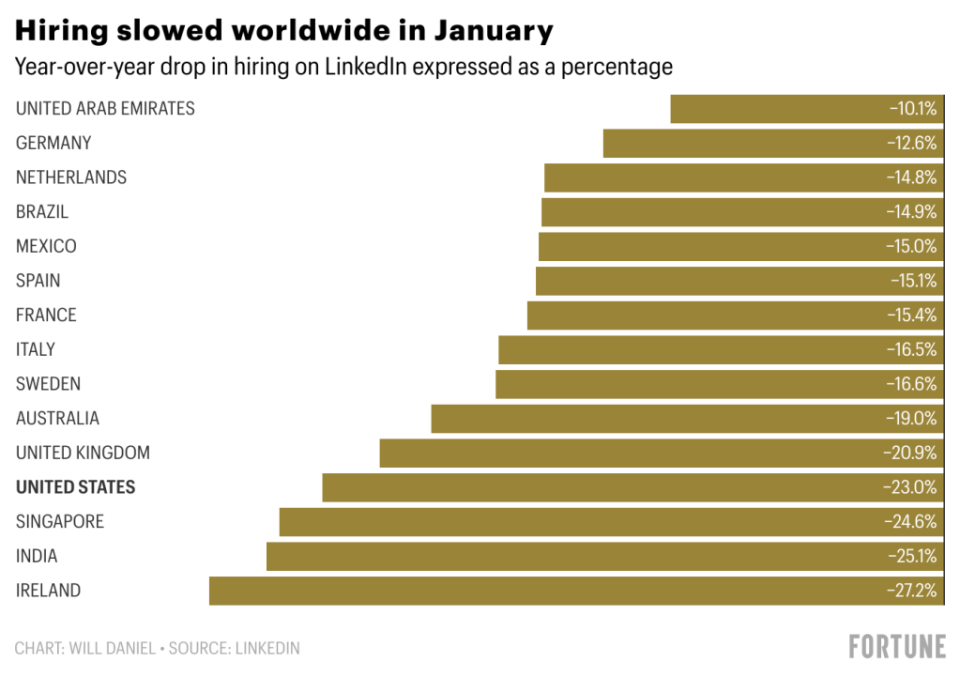Despite layoffs and hiring freezes at Big Tech firms including Amazon and Meta, the labor market has proved to be incredibly resilient. The U.S. economy added 517,000 jobs last month, topping economists’ estimates and pushing the unemployment rate to a 53-year low of 3.4%.
Forecasters hadn’t anticipated the robust jobs report, given the Federal Reserve’s yearlong campaign of interest rate hikes to fight persistent inflation, which typically causes higher unemployment. Even Fed Chair Jerome Powell said Tuesday at the Economic Club of Washington, D.C., that the report was “stronger than anyone I know expected.”
But new data from LinkedIn shows the strength of the labor market may be fading. Hiring through the employment-focused social media site sank 23% year over year in the U.S. in January.
“The U.S. labor market is starting to normalize with a slowdown in hiring, quits, and wage growth,” Rand Ghayad, head of economics and global labor markets at LinkedIn, explained in a Tuesday article. “Companies have started to tighten their belts and take a more judicious approach to recruiting.”
While hiring was down “across almost all countries” on LinkedIn in January, U.S. hiring slowed more than most—only Ireland (–27.2%), India (–25.1%), and Singapore (–24.6%) posted worse results. LinkedIn derives its country-level hiring measure by dividing the number of users who add a new employer to their profile during the month their new job began by the total number of users in that country.

LinkedIn also studied users’ posts for signs that labor market strength is waning, and the recent data isn’t pretty. The number of posts mentioning the words “layoff” or “retrenchment” on LinkedIn soared 37.7% between Dec. 26, 2022, and Jan. 22, 2023, compared with the four weeks prior. And posts mentioning “open to work” increased by 18.5% over the same period.
“There is evidence that the labor market is cooling, beyond the ongoing layoff announcements from industries that saw massive over-hiring during the pandemic (i.e., real estate, technology, information and media, etc.),” Ghayad noted.
The economist pointed to the “gradually declining” ratio of job openings to active applicants over the past few months as evidence of companies’ hiring slowdown. But he also noted labor market conditions vary by industry, as the effects of COVID-related disruptions are still being felt by some companies today. The tech sector, for example, has returned to its “pre-pandemic baseline” in hiring, while in other industries, like energy and health care, Ghayad said it is still “very much a job seeker’s market.”
“The U.S. labor force is currently short of a net 3 million people since the beginning of the pandemic. The sudden drop in the availability of labor has led to an uneven recovery across industries,” he said. “While conditions in some industries have cooled down significantly, some are still struggling and unable to return to being fully staffed.”
But despite the slowdown in hiring in the U.S. in January—and warnings from his economist peers— Ghayad isn’t predicting an outright recession.
“The economy is projected to slow further in 2023, while inflation is expected to moderate as labor markets soften and wage pressures abate. Though recession risks remain elevated, the probability that the Fed will steer the overheated economy to a soft landing has increased over the past few months,” he wrote.
This story was originally featured on Fortune.com
More from Fortune:
5 side hustles where you may earn over $20,000 per year—all while working from home
The 5 most common mistakes lottery winners make
This is how much money you need to earn annually to comfortably buy a $400,000 home
The Billionaire Tax: how much the ultra wealthy could end up paying under Biden’s new plan and what it means for your tax bill
Source: https://finance.yahoo.com/news/latest-jobs-report-red-hot-182815798.html
